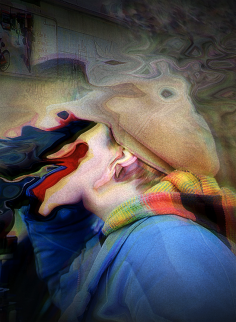Matthias Dörfelt
Selective Memory Theatre
source: emergentlocality
Selective Memory Theatre is a machine-like perception and memory installation, that thematises the desire to teach the non-forgetting digital memory to forget. It thereby covers the selectionistic nature of the individual mind, that marks the human sensing and remembering as the subjective and biased – but therefore human and functional – act that it is. The installation consists of two projections, the perception and the memory layer. Both will be explained in what follows.
The perception layer represents the sensory memory before any priorities have been chosen. It receives the newest images from flickr which get distorted, mixed and blended to persuade sensory noise. The memory layer is a metaphor for the short- and long-term memory. It is the place where existing memories can be activated by new perceptions, and thus be called to mind. The perception layer asks the memory layer for each new image if it is similar to already existing memories. This happens based on the tags the flickr images are provided with. If a relevant image is found, it gets focused in the perception layer so that it stands out. At the same time the most similar memory is activated inside the memory layer. Both images enter into a dialogue representing the connection of the new perception and the old memory. Afterwards, the newly sensed image gets saved inside the memory layer so that the criteria for newly sensed images is changed. This demonstrates the interrelation between perception and memory that oblivion results from.
Technical Notes:
The project was entirely programed in c++, OpenGL and glsl using openFrameworks. Each projection is running and rendered in real time on one Mac-Mini. They communicate over network using a small Protocol written on top of TCP to realize the interaction between both projections.
.
.
.
.
.
.
.
source: mokafoliode
Selective Memory Theatre is a machine-like perception and memory installation, that thematises the desire to teach the non-forgetting digital memory to forget. It thereby covers the selectionistic nature of the individual mind, that marks the human sensing and remembering as the subjective and biased – but therefore human and functional – act that it is. The installation consists of two projections, the perception and the memory layer. Both will be explained in what follows.
The perception layer represents the sensory memory before any priorities have been chosen. It receives the newest images from flickr which get distorted, mixed and blended to persuade sensory noise. The memory layer is a metaphor for the short- and long-term memory. It is the place where existing memories can be activated by new perceptions, and thus be called to mind. The perception layer asks the memory layer for each new image if it is similar to already existing memories. This happens based on the tags the flickr images are provided with. If a relevant image is found, it gets focused in the perception layer so that it stands out. At the same time the most similar memory is activated inside the memory layer. Both images enter into a dialogue representing the connection of the new perception and the old memory. Afterwards, the newly sensed image gets saved inside the memory layer so that the criteria for newly sensed images is changed. This demonstrates the interrelation between perception and memory that oblivion results from.
.
.
.
.
.
.
.
source: fastcodesign
Digital installations that claim to mimic the ineffable processes of our minds usually do nothing of the sort, but Matthias Dörfelt’s “Selective Memory Theatre” is subtler than most. To him, the main difference between our memories and digital files is that our minds can actually forget things stored within them, whereas computers — outside of server crashes and file corruptions — never do. “Selective Memory Theatre” pulls images off of the image-sharing site Flickr, then uses two layers of data-processing to distort, remix, and display them in a way that metaphorically mimicks the way our own brains store and reconstruct memories.
Neuroscience tells us that memories, unlike digital data files, are re-built every time we recall them. Dörfelt’s art makes a lot of other conjectures about how the brain turns raw perceptions into coherent memories, and if you feel like fact-checking them, head over to Mindhacks.com and go nuts. But here’s how “Selective Memory Theatre” works. First, a programmed “perception layer” sucks in new images from Flickr and mixes them into a kind of raw noise in the “memory layer.”
Then, the two layers communicate: as new images come into the perception layer, it uses the photo’s Flickr tags to associate it with other, similar images in the memory layer. Those images then get called back up and displayed at 30 frames per second, as do the connections themselves (visualized as glowing nodes in a network).
According to Dörfelt, “this demonstrates the interrelation between perception and memory, which oblivion results from.” Er, ok. In case you couldn’t already tell, the best way to appreciate “Selective Memory Theatre” is just to bask in its mesmerizing visuals, not their quasi-scientific interpretations. And there’s plenty to appreciate.


